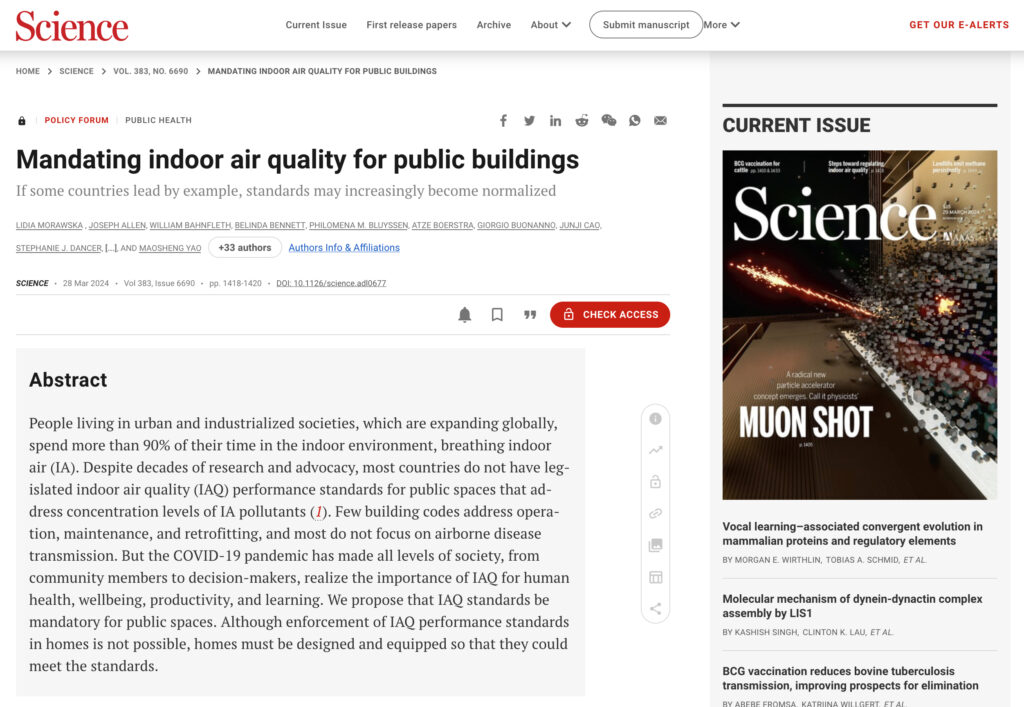💡 International experts set out standards for monitoring three key indoor pollutants.
💡 Adequate ventilation for number of occupants and activities must be taken into account.
💡 Carbon dioxide and PM2.5 particles and carbon monoxide are three pollutants requiring monitoring to assess healthy ventilation levels.
A group of international experts led by QUT (Queensland University of Technology)‘s Distinguished Professor Lidia Morawska has presented a blueprint for national indoor quality standards for public buildings, in an article in the prestigious journal Science. The experts addressed setting standards for three key indoor pollutants – carbon dioxide (CO2), carbon monoxide (CO), PM2.5 which are particles so small they can lodge deep in the lungs and enter the bloodstream – and ventilation rate.
D/Prof. Morawska, the Director of Thrive IAQ, internationally known, among others, for leading the appeal to the World Health Organization to recognise the airborne transmission spread of the COVID-19 virus early in the pandemic, has continued to raise the importance of adequate indoor air quality (IAQ) for public spaces.
“Most countries do not have any legislated IAQ performance standards for public spaces that address concentration levels of IA pollutants,” D/Prof. Morawska said. “To have practical value, IAQ standards must be implementable by designing new buildings that are built, operated and maintained to standard or retrofitted to meet the standards. While there is a cost in the short term, the social and economic benefits to public health, wellbeing and productivity will likely far outweigh the investment in cost in achieving clean indoor air.”
D/Prof. Morawska said CO2 sensors were readily available, inexpensive and robust and should be used as a proxy to measure pathogens and CO2 during human occupancy in a public space. “CO2 can serve as a proxy for occupant-emitted contaminants and pathogens and to effectively assess ventilation quality,” she said.
“We propose a CO2 concentration level of 800ppm with the proviso that outdoor concentration is used as a baseline and recognition of the fact that outdoor concentrations are increasing due to emissions to the atmosphere that outweigh removal. Another key indicator of air quality we addressed is the amount of PM2.5 and we propose the WHO air quality guidelines as a basis for indoor air quality standards but with a 1-hour averaging time, as the 24 hours of the WHO AQG is much longer than people usually spend in public places.”
D/Prof. Morawska said mechanical ventilation systems should remove and dilute human-emitted and other indoor-generated pollutants at a higher rate than their production so that they would not accumulate in indoor air.
“The technologies for measuring ventilation already exist in most modern mechanically ventilated buildings but monitoring ventilation rates in terms of clean air delivered to the space requires us to consider the number of people and their activities in the space to ensure adequate IAQ. A practical ventilation standard could be air from outside (assumed to be clean), or clean recirculated air to the entire occupied zone and with airflow not directed from one person to another.”
“Additional measures in support of ventilation, such as air cleaning and disinfection, could greatly reduce the need to increase the outdoor air supply, which carries a heavy energy demand. Filtering recirculated air is an effective way to reduce concentration of, and thus our exposure to, airborne particulate matter, allergens and pathogens.”
Mandating indoor air quality standards in public buildings was published in Science: https://www.science.org/doi/abs/10.1126/science.adl0677
Morawska, L., Allen, J., Bahnfleth, W., Bennett, B., Bluyssen, P. M., Boerstra, A., Buonanno, G., Cao, J., Dancer, S. J., Floto, A., Franchimon, F., Greenhalgh, T., Haworth, C., Hogeling, J., Isaxon, C., Jimenez, J. L., Kennedy, A., Kumar, P., Kurnitski, J., . . . Yao, M. (2024). Mandating indoor air quality for public buildings. Science, 383(6690), 1418-1420. https://www.science.org/doi/abs/10.1126/science.adl0677
The paper is also available for download from QUT ePrints (an open access repository, with a copy of the authors’ accepted manuscript): https://eprints.qut.edu.au/247686/
#ThriveIAQ #QUT #QUTScience #QUTEngineering #QUTArchitecture #IAQ #PublicHealth #COVID19
